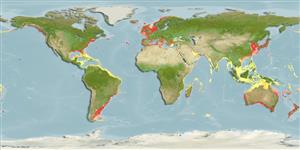Common names from other countries
Classification / Names / Names
Common names | Synonyms | Catalog of Fishes (gen., sp.) | ITIS | CoL | WoRMS
Environment: milieu / climate zone / depth range / distribution range
Ecology
Benthic; depth range 0 - 100 m (Ref. 865). Tropical
Indo-Pacific, Atlantic Ocean, Mediterranean and Antarctic.
Length at first maturity / Size / Weight / Age
Maturity: Lm ? range ? - ? cm Max length : 10.0 cm TL male/unsexed; (Ref. 865)
Size refers to tube length (Ref. 865). Found on exposed rocky shores, amongst Mytilisepta virgata beds (Ref. 126136). An active suspension-feeder (Ref. 96376). Fouling species attached to raft frames in mariculture zones (Ref. 127121).
Life cycle and mating behavior
Maturity | Reproduction | Spawning | Eggs | Fecundity | Larvae
Members of the class Polychaeta are gonochoric (sexual), gametes are spawned through the metanephridia or body wall rupturing.
Gotshall, D.W. 2005. (Ref. 865)
IUCN Red List Status (Ref. 130435)
CITES status (Ref. 108899)
Not Evaluated
Not Evaluated
Human uses
| FishSource |
Tools
More information
Age/Size
Growth
Length-weight
Length-length
Morphology
Larvae
Abundance
Internet sources
Estimates based on models
Preferred temperature
(Ref.
115969): 8.6 - 25.4, mean 14.7 (based on 1956 cells).
Price category
Unknown.
